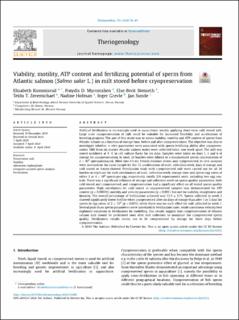| dc.contributor.author | Kommisrud, Elisabeth | |
| dc.contributor.author | Myromslien, Frøydis Deinboll | |
| dc.contributor.author | Stenseth, Else-Berit | |
| dc.contributor.author | Zeremichael, Teklu Tewoldebrhan | |
| dc.contributor.author | Hofman, Nadine | |
| dc.contributor.author | Grevle, Inger Synnøve | |
| dc.contributor.author | Sunde, Jan | |
| dc.date.accessioned | 2020-09-14T11:34:10Z | |
| dc.date.available | 2020-09-14T11:34:10Z | |
| dc.date.created | 2020-04-20T14:26:13Z | |
| dc.date.issued | 2020 | |
| dc.identifier.issn | 0093-691X | |
| dc.identifier.uri | https://hdl.handle.net/11250/2677668 | |
| dc.description.abstract | Artificial fertilization is increasingly used in aquaculture, mostly applying short-term cold stored milt. Large scale cryopreservation of milt could be valuable for increased flexibility and acceleration of breeding progress. The aim of this study was to assess viability, motility and ATP content of sperm from Atlantic salmon as a function of storage time, before and after cryopreservation. The objective was also to investigate whether in vitro parameters were associated with sperm fertilizing ability after cryopreservation. Milt from six mature Atlantic salmon males were collected twice, one week apart. The milt was stored undiluted at 5 °C in cell culture flasks for six days. Samples were taken on days 1, 3 and 6 of storage for cryopreservation. In total, 36 batches were diluted to a standardized sperm concentration of 2 × 109 spermatozoa/mL, filled into 0.5 mL French medium straws and cryopreserved. In vitro analyses were assessed on the same sample for the 72 combinations of male, collection week, days of storage and cold stored or frozen-thawed. Fertilization trials with cryopreserved milt were carried out for all 36 batches in triplicate for each combination of male, collection week, storage time and sperm:egg ratios of either 2 or 4 × 106 sperm per egg, respectively, totally 218 experimental units, including two egg controls. There was a significant influence of storage and collection week on sperm quality parameters, both cold stored and cryopreserved, and cryopreservation had a significant effect on all tested sperm quality parameters. High correlations for cold stored vs cryopreserved samples was demonstrated for ATP content (p < 0.00001), motility and velocity parameters (p < 0.001), but not for viability, straightness and linearity. The overall percentage of fertilization achieved was 73.9 ± 1.7%. Sperm collected in week 2 showed significantly lower fertility when cryopreserved after six days of storage than after 1 or 3 days for sperm to egg ratios of 2 × 106 (p < 0.005), while there was no such effect for milt collected in week 1. Several post-thaw sperm parameters were correlated to fertilization rates, while curvilinear velocity best explained variations in fertilization by modelling. Our results suggest that cryopreservation of Atlantic salmon milt should be performed soon after milt collection to maximize the cryopreserved sperm quality. Fertilization results seems not to be compromised by storage for three days before cryopreservation. | en_US |
| dc.language.iso | eng | en_US |
| dc.rights | Navngivelse 4.0 Internasjonal | * |
| dc.rights.uri | http://creativecommons.org/licenses/by/4.0/deed.no | * |
| dc.subject | Lakseoppdrett | en_US |
| dc.subject | Salmon breeding | en_US |
| dc.subject | Inseminering, kunstig / kunstig befruktning | en_US |
| dc.subject | Insemination, Artificial | en_US |
| dc.subject | In vitro spermieanalyse | en_US |
| dc.subject | In vitro sperm analyses | en_US |
| dc.subject | Bevaring / preservering, biologisk | en_US |
| dc.subject | Preservation, Biological | en_US |
| dc.title | Viability, motility, ATP content and fertilizing potential of sperm from Atlantic salmon (Salmo salar L.) in milt stored before cryopreservation | en_US |
| dc.type | Peer reviewed | en_US |
| dc.type | Journal article | en_US |
| dc.description.version | publishedVersion | en_US |
| dc.subject.nsi | VDP::Basale biofag: 470 | en_US |
| dc.subject.nsi | VDP::Basic biosciences: 470 | en_US |
| dc.source.pagenumber | 58-65 | en_US |
| dc.source.volume | 151 | en_US |
| dc.source.journal | Theriogenology | en_US |
| dc.identifier.doi | 10.1016/j.theriogenology.2020.04.008 | |
| dc.identifier.cristin | 1807156 | |
| dc.relation.project | Regionale forskningsfond Innlandet: 224814 | en_US |
| cristin.ispublished | true | |
| cristin.fulltext | original | |
| cristin.qualitycode | 2 | |

